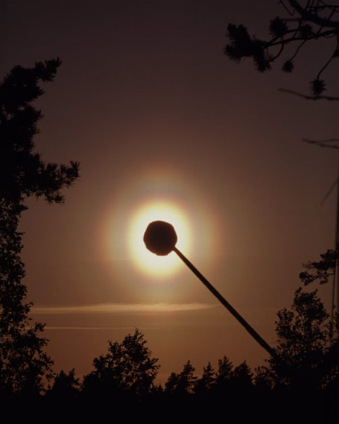Pollen Corona
The Enigmatic Beauty of Pollen Corona
Have you ever noticed the ethereal beauty of a pollen corona? These captivating atmospheric phenomena occur when light interacts with pollen grains suspended in the air. While the transparency or opacity of the particles may not affect corona formation, their size and shape play a crucial role in creating these mesmerizing displays.
In the Northern forests, trees release vast quantities of pollen each year. Interestingly, the pollen grains from a particular tree species tend to have similar sizes, making them ideal candidates for corona formation. Unlike water droplets, which are spherical in shape, pollens are non-spherical and often possess air sacs that aid in their wind dispersal. As these pollen grains drift through the air, they become oriented in specific ways, resulting in elongated coronae with occasional bright patches on their rings.
Pollen grains are relatively large compared to other atmospheric particles, which means that their coronae appear smaller in size. To observe a pollen corona, one must look near a well-shielded sun (taking care to protect their eyes!) or, preferably, search for these captivating phenomena in the reflection of the sky on a calm pool of water or through a darkened glass surface.
The intricate patterns and colors exhibited by pollen coronae have fascinated scientists and nature enthusiasts alike. By studying these phenomena, researchers gain insights into the properties of pollen grains and their behavior in the atmosphere. Here are some fascinating facts about pollen coronae:
-
Size Matters: The size of the pollen grains greatly influences the appearance of the corona. Larger grains tend to create smaller coronae, while smaller grains may produce larger and more intricate patterns.
-
Unique Orientation: Due to their non-spherical shape and air sacs, pollens have a distinct orientation as they float through the air. This orientation contributes to the elongated shape of the coronae.
-
Bright Patches: Occasionally, pollen coronae exhibit bright patches on their rings. These patches may result from variations in the density or distribution of the pollen grains within the corona.
-
Pollen Diversity: Different tree species release pollen with varying sizes and shapes, leading to a wide range of corona patterns. Each type of pollen offers a unique spectacle to behold.
-
Optimal Viewing Conditions: To observe the intricate details of a pollen corona, it is best to find a location with minimal atmospheric disturbances. Calm bodies of water and darkened glass surfaces provide ideal reflective surfaces for witnessing these captivating phenomena.
-
Photographic Delights: Photographers have captured stunning images of pollen coronae, showcasing their intricate beauty and adding to our understanding of these atmospheric wonders.
-
Scientific Significance: Studying pollen coronae not only allows us to appreciate their aesthetic appeal but also provides valuable insights into atmospheric optics and the behavior of particles in the air. Researchers can gain a deeper understanding of how light interacts with various types of particles and the role of particle shape in corona formation.
-
A Gateway to Nature: Observing pollen coronae is an excellent way to connect with nature and appreciate the intricate processes that occur in our atmosphere. It serves as a reminder of the countless hidden wonders that surround us every day.
-
Seasonal Spectacle: Pollen coronae are more likely to be observed during the pollen season when trees release copious amounts of pollen into the air. Keep an eye out for these enchanting displays during this time.
-
Exploring Further: If you find yourself captivated by pollen coronae, consider delving deeper into the field of atmospheric optics. There is a vast array of phenomena to explore, each offering its own unique blend of scientific intrigue and natural beauty.
So, next time you find yourself gazing at the sky or reflecting upon a tranquil pool of water, keep an eye out for the enigmatic beauty of a pollen corona. These captivating displays serve as a testament to the wonders of our natural world and the intricate interplay between light and particles in our atmosphere.

Pollen Corona, Degerby, Finland on 11th June '94 by Marko Riikonen (site) . Image ©Marko Riikonen, shown with permission.
It little matters for corona formation whether small particles are transparent or opaque. What does matter is their size and their shape.
Each year trees of the Northern forests release copious clouds of pollen. The pollen grains from a given tree variety usually have very similar sizes - ideal for corona formation.
Unlike water droplets, pollens are non spherical. Many have air sacs to assist wind dispersal and they are consequently become specially oriented as they drift in the air. The result is elongated coronae, sometimes with bright patches on their rings.
Pollens are comparatively large and so their coronae are small. Look close to a well shielded sun (take care of your eyes!) or, preferably, search for them in the reflection of the sky in a pool or dark glass.
Another pollen corona.
Note: this article has been automatically converted from the old site and may not appear as intended. You can find the original article here.
Reference Atmospheric Optics
If you use any of the definitions, information, or data presented on Atmospheric Optics, please copy the link or reference below to properly credit us as the reference source. Thank you!
-
<a href="https://atoptics.co.uk/blog/pollen-corona/">Pollen Corona</a>
-
"Pollen Corona". Atmospheric Optics. Accessed on December 21, 2024. https://atoptics.co.uk/blog/pollen-corona/.
-
"Pollen Corona". Atmospheric Optics, https://atoptics.co.uk/blog/pollen-corona/. Accessed 21 December, 2024
-
Pollen Corona. Atmospheric Optics. Retrieved from https://atoptics.co.uk/blog/pollen-corona/.